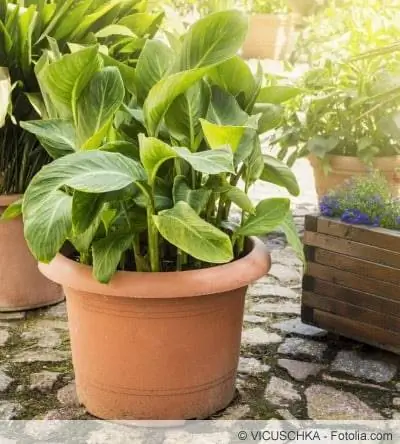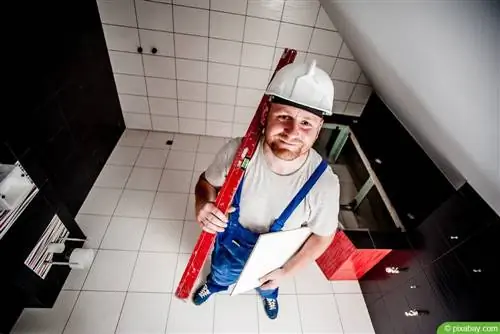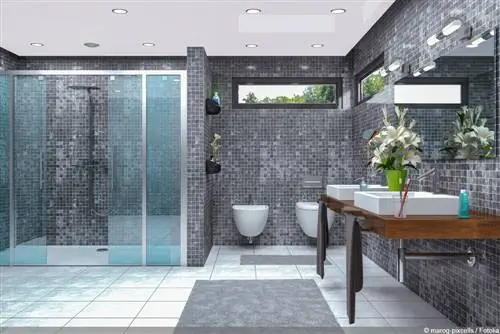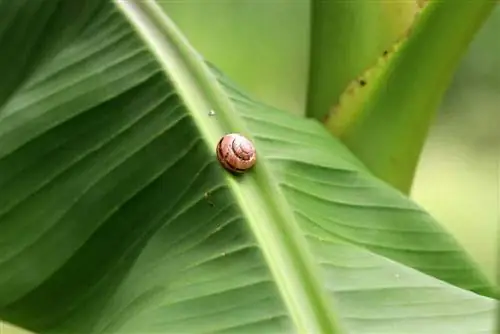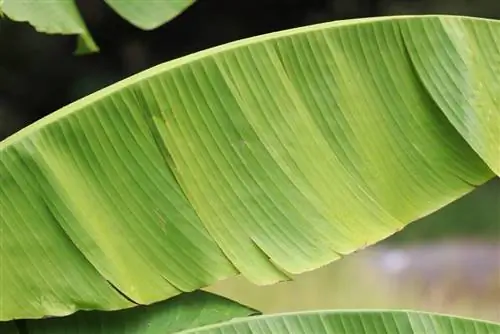- Author admin [email protected].
- Public 2023-12-17 03:39.
- Last modified 2025-01-24 12:45.
Musa Tropicana is an artificial name. Casually translated as ornamental banana, banana palm or indoor banana, almost everyone knows what is meant. Different varieties of ornamental bananas are offered under the name Musa Tropicana. The most commonly encountered varieties are Musa acuminata. The small-sized 'Dwarf Cavendish' is a popular variety for indoor cultivation. But it can also grow up to two meters high under good conditions.
Musa acuminata cultivars are very suitable for pure indoor cultivation. They belong to the banana family (musacea), belong to the ginger order (zingiberales) and are therefore neither trees nor palms.
Location
All banana plants come from the tropical regions of Southeast Asia and South America. So there's no question that our Musa Tropicana also needs a lot of light, warmth and humidity in the room.
If you buy a plant that is still quite young, you should not expose it to the blazing sun all day for the first two years. The young leaves burn easily. Older plants are more robust and tolerate intense sunlight quite well. But the location must be very bright. If you have a balcony or terrace, you can also put your ornamental banana outside during the summer. Here it loves a warm, wind-protected location. In windy conditions, as well as in strong drafts in the room, the leaves tend to fray. This may visually disturb some people, but it does not harm the banana plant itself.
Floor
The ornamental banana does not have any great demands on its substrate. Regular potting soil or houseplant soil works well. If you are particularly well-intentioned, you can mix the soil with clay granules or sand, 1 part to 3 parts soil. This improves water drainage. If the roots of the ornamental banana are permanently waterlogged, they will rot.
Watering and fertilizing
In the growth phase, from April to September, the ornamental banana needs plenty of water. The hotter it is, the more water it needs. When it is cooler and in winter, one to three waterings a week are enough. The root ball must never dry out completely. Nor should it be permanently wet. After watering, the water should not remain in the saucer or planter for longer than one to two hours. Almost as important as the irrigation water is relatively high humidity. You can spray the plant regularly. Especially in winter, when the air from the heating system is dry, it is important to ensure a certain level of humidity. The easiest way is to place a container of water next to the plant.
With the fast-growing banana plant, fertilization is more a question of space than a question of survival. In short, those who have a lot of space, both in height and width, fertilize heavily, otherwise less. A commercially available green manure will serve you well here. Fertilization is carried out in the growth phase, from April to September. During these months, liquid fertilizer can be given once a month. Fertilizer sticks are very practical. They are put into the potting soil once at the beginning, i.e. in April and then again in June/July.
Repotting

Because of its already mentioned rapid growth, the ornamental banana often needs a larger pot, especially in the first few years. A final tip for repotting is that the pot is completely rooted. The new vessel must not be too large. In a pot that is too large, the plant initially puts all its strength into new root formation; above the ground it loses strength and vigor.
If you buy your ornamental banana as a 20 centimeter high plant, you can almost watch it grow. After just one year it can reach a height of one meter (depending on the variety). You can constantly see small daughter plants sprouting across the width. When repotting, they can be easily separated from the mother plant and grown as separate plants or passed on.
The best time to repot is just before the next growing season, at the beginning of the year.
Purchase
When buying a Musa Tropicana, you should first find out exactly what variety it is. There are many different varieties and include pretty much all variants for good growing conditions in the winter:
- hardy varieties
- warm winter varieties
- winter cold varieties
Only the last two varieties mentioned are suitable for the apartment. Those that have to be kept cool (10-15°C) over the winter are not suitable as greenery for the warm room all year round. There are also differences in size, flowering and leaf colors that you can't necessarily tell at first glance, especially not from the name Musa Tropicana.
Propagate
Banana plants can be easily propagated using their shoot axes. Over time, sometimes more sometimes less numerous, they sprout out of the ground right next to the main plant. It's best to separate them from the mother plant the next time you repot them and put them back in separate pots. Normal potting soil and good drainage in the pot will allow it to grow into a new, small ornamental banana within a short time.
Propagation by seeds is a little more demanding. Because first and foremost it's about getting the mother plant to bloom. The first bloom may take several years or may never bloom. If you still want to try sowing and don't have a flowering ornamental banana, you can buy seeds of different varieties from specialist retailers.
The seeds are soaked in water a day before and can then be placed directly in a small pot with potting soil. Now it's time to keep it warm, 25-30°C. The substrate must always be kept moist. And: be patient! It can take a few weeks for a seedling to break through the soil.
Tip:
Even a banana shoot dies at some point. Mostly after flowering. Since many indoor ornamental bananas do not bloom, the plant simply dies over the years. You can tell by the fact that it develops a lot of small side shoots.
Diseases and pests
As is so often the case with houseplants, a pest infestation or disease in the ornamental banana is usually related to care errors or an unfavorable location.
First of all, an all-clear. If the banana sheds the lower leaves from time to time, this is completely normal as long as the rest of the plant appears he althy and produces new leaves.
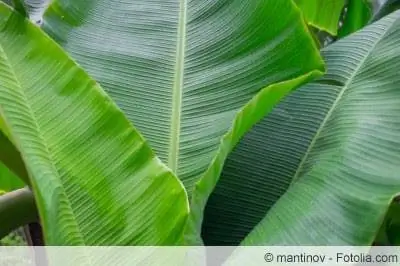
Conditions are often favorable for pests and diseases, especially in winter. Either the plant is too dark, the air is too dry or it receives too little or too much water. This weakens the plant and creates an opportunity for spider mites, scale insects and the like.
Spider mites
If a houseplant is weakened, they are the first to appear out of nowhere. In no time they have woven leaves and styles with their fine web. Your preferred climate is dry, warm heated air. The first measures:
- shower infected plants with lukewarm water
- then surrounded with plastic film for a few days to create as much humidity as possible (no longer than three days, otherwise there is a risk of mold forming)
- Proven home remedies: spraying several times with an oil-containing water mixture, with soapy water or a garlic decoction
Thrips
Thrips also prefer to appear in dry and warm heating air in winter. The infestation is usually first noticed by some leaves that look unusually curled or stunted. Therefore, always ensure sufficient humidity in winter. First measures against a thrips infestation:
- Isolate plant from other plants immediately
- Give the plant a thorough lukewarm shower, ensuring that eggs or larvae are not washed onto the soil.
- spray or shower regularly afterwards
- Hang up blue boards (specialist retailers), the thrips will stick to them
Tip: If the ornamental banana has lost all its leaves in winter, it is definitely because it was too dark. But you should continue to care for the stalk next year. In most cases it will sprout again in spring.
Conclusion
No matter which variety or breed you choose, an ornamental banana is a green, exotic ornament for your room. Plus, you can watch her grow and that's extremely satisfying. If you are a little careful in winter to ensure that it is not too dry and dark and give it plenty of water in summer without waterlogging, you are doing everything right. Maybe after three to four years it will even produce flowers. What a joy!

